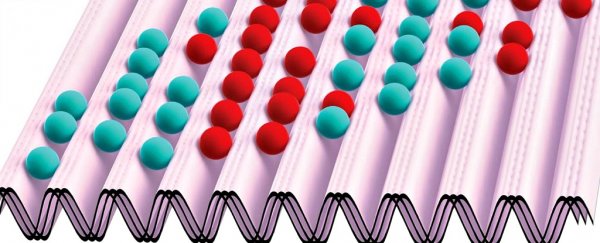Researchers have finally confirmed a decades-old set of rules that describes strange shifts in space and time, known as continuous phase transitions.
These aren't the traditional phase transitions we learnt about in high school, where solids transform into liquids, or liquids to gas. In continuous phase transitions, tiny, quantum defects are formed, where some matter is stuck between regions in distinct states. And now, for the first time, physicists can actually explain how that works.
That's important, because even though we can't see these continuous phase transitions happening around us, they play a huge role in the shifts and evolution of physical systems.
One of the best examples of a continuous phase transition is the spontaneous symmetry breaking in the early Universe - when many of the unique properties of our Universe, such as time and matter, arose.
Without that continuous phase transition, which occurred across both space and time, we wouldn't be here today.
But understanding the principles of these continuous phase transitions won't just help us better understand how the Universe first formed, it will also help us understand the behaviour of materials on the quantum level - because this new research confirms for the first time that both processes are controlled by the same set of rules.
Those rules are the Kibble-Zurek mechanism (KZM), which was first proposed in 1976, but has never been demonstrated until now.
The reason those rules are so important is because the defects formed by these continuous phase transitions are crucial cosmological phenomena such as domain walls, cosmic strings, and textures. The KZM predicts how these defects will form in space and time when a physical system goes through a continuous phase transition.
And now we finally know that it works.
"We study phase transitions because it is one of the most fundamental questions that puzzle us," said one of the researchers, Cheng Chin, from the University of Chicago.
"What is the origin of the complex structure of the Universe, how do imperfections emerge and how do identical materials develop distinct properties over time?"
Chin and his team were able to provide the first clear demonstration of the KZM by observing a continuous phase transition in gaseous caesium atoms cooled down to temperatures near absolute zero.
Using a laser, the researchers created an optical lattice that lined up the atoms in patterns. They then used sound waves to shake the optical lattice and drive the atoms across a continuous, ferromagnetic quantum phase transition.
This caused each atom to divide into different domains with either positive or negative momentum, and the faster the structure was shaken, the smaller the domains were.
Impressively, the team found that the resulting structure was consistent with what the KSM would have predicted all the way back in 1976.
This suggests that these KSM 'rules' for how matter will behave across space time during a continuous phase transition will be applicable to all physical systems - whether that's caesium gas atoms or the early Universe.
And based on these rules, researchers will now be able to go back and figure out how the unique 'defects' we see in the Universe today would have formed during those early continuous phase transitions.
"What we learn from testing KZM in our system is not about the origin of the universe," said Chin.
"Rather it is about how complex structure is developed through a transition. These are two different but related questions. You can ask: 'Where does snow come from?' or 'Why do snowflakes have a beautiful crystal structure?' Our investigation is more into the second question."
Similar continuous phase transitions are also found throughout the natural world, in liquid crystals, superfluid helium, and even cell membranes.
Erich Mueller, a physicist at Cornell University who wasn't involved in the study, said the findings were "a remarkable demonstration of the universality of physics".
"The same theory that is used to explain the formation of structure in the early Universe also explains the formation of structure in the cold gases," he added.
Now that the KZM has been confirmed, it opens up the door for using atoms in the lab to model and better understand large-scale processes, happening here on Earth, or light-years away in space.
"While cosmologists are still searching for evidence of the Kibble-Zurek mechanism, our team actually saw it in our lab in samples of atoms at extremely low temperatures," said Chin.
"We are on the right track to investigate other intriguing cosmological phenomena, not only with a telescope, but also with a microscope."
The research has been published in Science.
